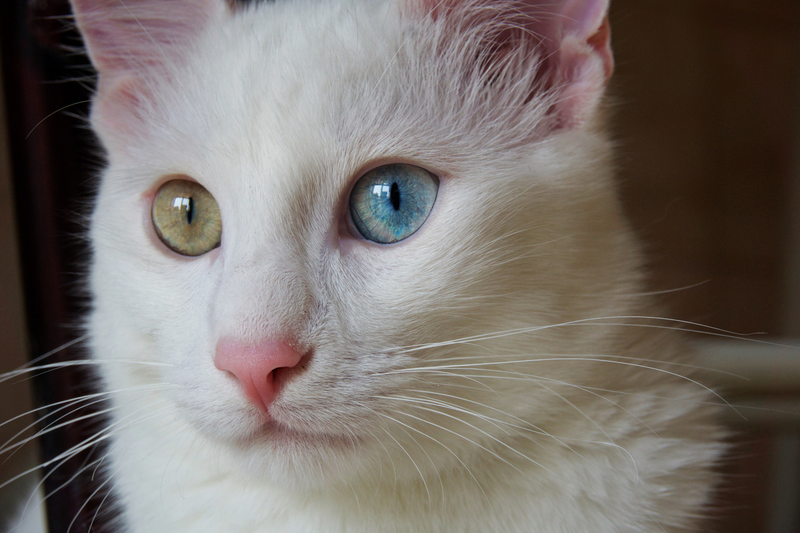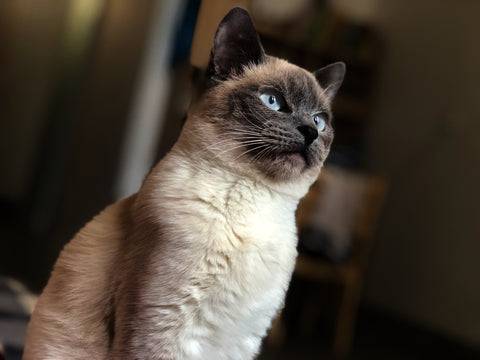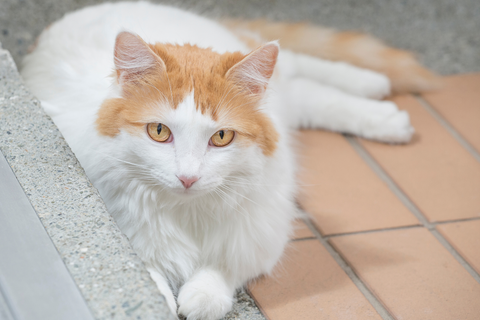
Origins
The Turkish Angora, formally known as the ‘Turkish Ankara’, is a naturally occurring domestic breed of cat, not to be confused with the slightly bigger Turkish Van. Angoras have been around for centuries, since the 1500s, and originate in the Ankara Region of Central Turkey. It is said that the first long-haired cat seen in Europe was brought from Ankara, leading many to believe it was a Turkish Angora.
Like all domestic cats, the Angora comes from the African Wild cat. Their long fur is said to stem from a spontaneous recessive mutation due to their inability to leave their dense mountainous environment and being forced to inbreed. It is in fact believed that all long-haired cats stem from the Angora breed.
The Angora’s history includes both bumping shoulders with royalty and facing the threat of going extinct. Marie-Antoinette as well as King Louis XV, for example, both loved the Angora breed. Towards the end of the French Revolution, Marie-Antoinette (trying to flee France) put her Turkish Angora aboard a boat headed for Maine, although she was herself unable to join her beloved cats. Upon the breeds arrival in Maine, they started to breed with local cats and helped create a new breed known as the Maine Coon.

Back in Europe, Angoras were slowly losing their adoration and began to be eclipsed by the Persian breed. Starting to lose their appeal, the Angora almost became extinct. Thankfully a zoo in Turkey kept the breed from the grim fate of extinction by having an exhibit featuring this breed in all their glory. To this day, you can still go visit these beautiful cats at the Ankara Zoo.
During the 1960s, a couple from America visited Turkey and toured the Ankara Zoo that held the Angoras. Falling for their beauty, the couple quickly became infatuated and requested permission to take some of the cats back to America. In the end, the couple was granted permission and upon arriving back in the States began breeding them.
Main features of Turkish angora cats
Often called the ‘ballerina’ of cat breeds, the Turkish Angora is equipped with a slender, long, and fine-boned body that is complemented by a luscious coat of medium to long silky fur. People tend to say when an Angora moves, their silken coat catches the light and makes them seem to sparkle. Initially, the Turkish Angora was most known for their cream-colored fur; however, they are now being bred for more diverse colors and patterns. The Angora’s long fluff can now be found with tortoiseshell and calico markings that come in a range of colors.

The Turkish Angora’s slightly upturned almond eyes sit high on their heads, giving them an observant and noble look. Their eye colors can range from beautiful hues of blue, green, and amber. The most prized and coveted eye colors for Angoras come from a gene called Heterochromia iridum, in which the irises of each eye are different colors.
Angoras have large tufted ears that contrast with their small to medium size heads and stretched and elegant neck. They tend to have more fur up around the scruff of the neck as well as around the rear. The Angora’s hind legs tend to be taller than their front and taper down to tufted and small dainty paws.
The Turkish Angora’s tail is truly something to behold. The broad base flows into a narrow tip and is decorated with a plume of gorgeous fur. Many say the Angora’s tail mimics a large wispy feather, and as they walk the long and lush hind appendage stands tall and alert.
Personality
Turkish Angoras are known to be affectionate, loving, and form strong relationships with their families. They are extremely intelligent and love to please their owners. However, they do not come without their...quirks. Better than a security camera, these felines love to know and monitor what you are doing at all times. While they may be playing with toys or causing slight mischief by pouncing on unsuspecting items in the house, they will always be in the same room as their guardians. Angoras may help their owners untie their shoes and open doors at a whim. They are devoted and determined, tending to take the lead in the house hierarchy. Speaking to their guardians is a trait that most Angora owners know well—frequently having long and in-depth conversations with their humans. Angoras also have a tough time being left alone for long periods of time, needing a companion to converse with.

When it comes to people outside of their family, the Angora is curious. They will usually come running to the door to inspect the new guest, often taking the initiative to introduce themselves as the host. But while they are friendly in most situations, they tend to not like significant changes.
Angoras are acknowledged as a “dog-like” breed, as they are very playful and active. They love climbing and jumping and even going for a swim! That’s right; this breed tends to be drawn to water opting to maybe hop in the shower or bath with you. The Angora has also been seen taking a dip in streams or rivers with their guardians keeping a close eye.
Health and Care
The Angora is known to be a healthy cat; however, there are a few things to watch out for to keep this breed happy and healthy. White-furred and blue-eyed Angoras are often deaf. Angoras with the Heterochromia iridum (two different colored eyes) mutation are usually deaf on their blue-eyed side, which can cause their voices to be louder than anticipated.
One of the most important things to watch for is the Angora’s weight. Due to their ballerina-like bodies; It can be harmful to them to gain weight as their frame is not able to withstand the extra density.

Like most cats, Turkish Angoras may develop a heart condition known as HCM (Hypertrophic Cardiomyopathy), caused by the thickening of the heart muscles without a clear cause.
When it comes to grooming, Angoras are relatively easy to care for. Generally needing a good brush every day. Due to the Angora’s lack of undercoat, their long silky hair is not prone to tangle or shed, making them easier to groom.
Many recommend the Angora breed for first-time cat owners for their even and mild temper. However, because they are brilliant, they do need to be stimulated and challenged. Teaching them tricks and rewarding them with healthy treats is a great way not only to stimulate the feline, but also increase the human feline bond.
Cat Facts ABOUT TURKISH ANGORA CATS
- The most famous Angora is “Duchess” from The Aristocats!

- According to legend, Muhammad, who established the Islamic faith, had a great love for cats. Reportedly Muhammad’s favorite cat was an Angora named Muezza, meaning “Cherished”. As the story goes, one day Muhammad was called to prayer and as he began to get ready, he saw that Muezza was asleep on his robe sleeve. Instead of waking his beloved cat, he decided to cut the sleeve off; Leaving Muezza to rest peacefully. When Muhammad returned, his cat met him with a bow in thanks. In return, the feline was gifted with three soft strokes of Muhammad’s hand.
- In Turkey, Ankara is also known for its Angora rabbits and goats, adding the Turkish Angora to their list of national treasures.
Silky and Serene
The Turkish Angora with their looks and personality captivate many. This breed is strong and resilient, having their traits passed on to many cats is one to be honored. Angoras continue to rise in popularity and are admired by many cat fanciers around the world.
Do you have a Turkish Angora of your own? Share videos and photos with us on our Instagram!
Want to see if your cat shares DNA with the Turkish Angora? Grab one of our Basepaws DNA Kits!
For more about breeds, please follow the tags below.



